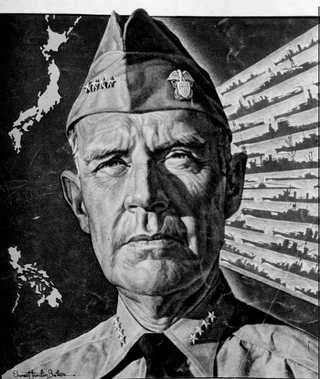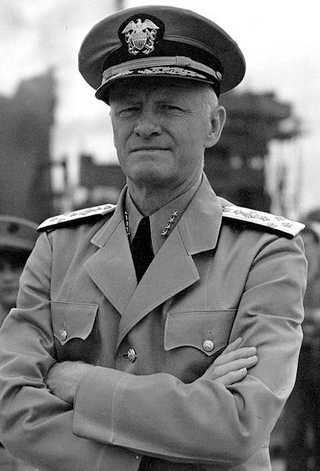Central Pacific 1943
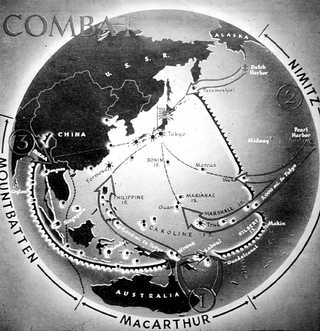 new Central Pacific strategy emerged in 1943
map from Time 1943/09 - big |
March 15 - King reorganized fleets
- new 5th Fleet under Spruance for Central Pacific
- with Halsey's 3rd Fleet in SW Pacific and MacArthur's 7th Fleet
May 8 - Joint Strategic Plan approved at Cairo
- South Pacific to Philippines (MacArthur)
- China to Hong Kong, B-29 air bases (Chiang)
- Central Pacific to Formosa, B-29 air bases (Nimitz)
Ultimate goal: Luzon "bottleneck" between China, Formosa, Luzon
- cut off Japanese shipping, protect air bases for new B-29
|
Hellcat on Yorktown 11/43
|
|
|
|
|
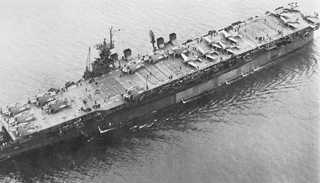
light carrier USS Independence CVL22
|
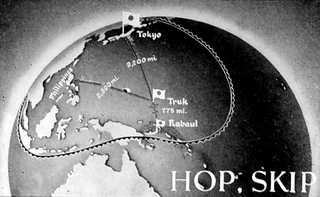
"Hop, Skip" - Rabaul from Time, 1943/07
|

"Jump" - Rabaul from Time, 1943/07
|
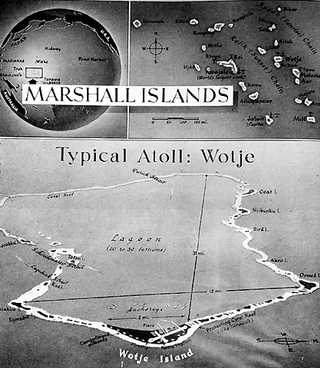
|
|
Spruance, from Time, 1944/06/26
|
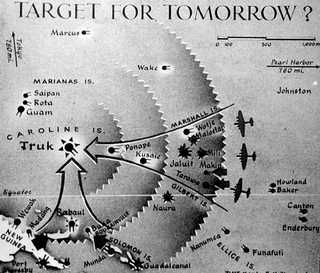
"Target for Tomorrow?" was Truk, from Time 1943/11
|
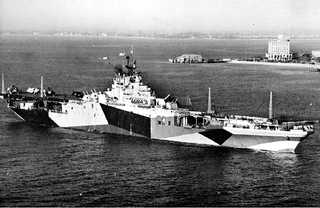
|
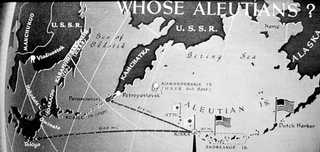
"Whose Aleutians?" from Time, 1943/05
|
|
Chester Nimitz 1942
|
May 30 - new USS Essex CV-9
- 1st of 24 "fast carriers" that were the idea of Admiral Sims in 1925
- authorized 1938, begun April '41, arrived May 30, 1943
June 10 - PAC-10
- creates multicarrier taskforce
- each TF = 3 carriers, 2 battleships, 6 cruisers, 18 destroyers
August 30 - public first told of new carriers
- 12 ready at Pearl Harbor (actually 11)
- Halsey fighting in South Pacific - within air range of Rabaul
Aug. 31 - Navy occupied Baker Island in Ellices
- but this outpost was already obsolete - Japan had made decision to pull back perimeter to new defense line from Kuriles to Marianas to west New Guinea to Burma
- Admiral Koga's Combined Fleet at Truk
- only mobile TF could break this line in the middle
Aug. 31 - 1st test raid on Marcus Island 2700 miles from Pearl
- TF15 formed under Charles "Baldy" Pownall
- Essex CV-9, new Yorktown CV-10, light carrier Independence,
- fast battleship Indiana, 2 cruisers, 10 destroyers, 1 sub, 1 oiler
- 1st Hellcat launched 4:22 am - dead calm - carriers at 30 knots into wind
- 5 waves flown - strafed and bombed island - some 2000 lb. blockbusters
- launch point 150 mi. away - no Japan fighters (Iwo 700 mi. away)
- was a success (except loss of 3 planes to AA fire)
- especially successful was navigation of new formation
Sep. 18 - 2nd test - air strike against Tarawa & Makin
- same formation and tactics as Marcus raid by TF15
- photos taken during raid for upcoming invasion
Oct. 5 - 3rd test by TF14 - Wake Island
- first time Hellcats fought Zeros - won
- radar used to direct defensive planes
- Japan fleet sailed to Wake, but found nothing - suspected only diversion
- Japanese reinforced Rabaul - 375 planes
Nov. 1 - Halsey sent TF38 to support landings at Bougainville
- first time fast carriers used in South Pacific
- carriers Saratoga and Princeton - under Ted Sherman
- air strikes against Buka-Boris - north end of island
- next day, withdrew to south
Nov. 2 - Empress Augusta Bay battle between cruiser fleets
Nov. 5 - TF38 air strike vs 4 Japan heavy cruisers at Rabaul
- 97 planes attacked - only 8 lost
- all 4 cruisers heavily damaged
- never again would Japan heavy ships come to Rabaul
Nov. 11 - air strike against Rabaul by 5 carriers now with Halsey
- TF38 and Essex, Bunker Hill, Independence
- but now, Japan counterattacked
- air strike of 120 land-based planes vs US carriers -
- 1st test of defensive ability of fast carriers
- battle lasted 46 minutes - 25 Japan planes downed
- only carriers and destroyers (cruisers had been detached)
Japanese fleet at Truk was crippled
- lost 1/2 fighters, all cruisers
- took six months to train fresh pilots
Nov. 12 - GALVANIC under Spruance began against Gilberts
- 200 ships, 27600 troops, 6000 vehicles, 117000 tons cargo
- 11 fast carriers in four groups
- but carriers held back in defensive areas
- Spruance feared attack by Japanese surface fleet (wrong)
- Spruance emphasized battleship bombardment for 3 hours before amphibious assault
- poor coordination between battleships (directing the bombardment) & carrier planes
Nov. 20 - Tarawa landings began on Betio
- Marine landing force under Gen. Holland Smith
- Marine casualties 3301, incl. 900 killed (Japan only 146 survive of 4836)
- USS Independence hit by torpedo plan from Kwajalein in Marshalls - out for 6 months
- was first island campaign covered by photographers - With the Marines at Tarawa used film shot by Norman Hatch and Marine Corps 2nd Division Photographic Service
Spruance blamed by Towers
- carriers should have carried out raids on all airfields in Marshalls first, especially Kwajalein, rather than held back in defensive sectors
Nimitz ordered Spruance to attack Marshalls
- but Spruance kept carriers to give air support to Marines on Tarawa
Nov. 24 - sub sunk USS Liscome Bay escort carrier - 644 killed, including Dorie Miller
Nov. 26 - Japan sent night torpedo plane attacks from Marshalls
- met by special night air group #6 under Adm. Arthur Radford on USS Enterprise
- 2 Hellcats and radar-equipped Avenger made the 1st night radar interception of the war
- were successful, but shot at each other also
- loss of the Hellcat of Navy's 1st ace Edward "Butch" O'Hare
Nov. 28 - Japanese air attacks ended as Tarawa fell
Dec. 4 - TF50 raid on Marshalls and Kwajalein - under Pownall
- but too cautious - got caught in night counterattack from Mitsubishi "Betty" torpedo bomber that had long range of 3000 mi. (twice any U.S. carrier plane), self sealing tanks, 5-7 man crew, was greatest threat to US carriers; missed on first raid and should have struck again quickly
Dec. 11 - FLINTLOCK
- Nimitz decided on Kwajalein, skipping Maloelap and Watje
- listening more seriously to air admirals such as Forrest Sherman
- carrier TFs could neutralize all islands around Kwajalein
- island leapfrogging not new - used by Adm. Kinkaid in Aleutians who skipped Kiska to take Attu in May '43
- Halsey skipped Kolembangora to take Vella Lavella in July
- future of Central Pacific advance depended on fast carriers
- if successful, would continue to Truk and Marianas
December - Navy command reorganization due to success of fast carrier taskforce
- King promoted to "Admiral of the Navy" - 5 stars (1st since Dewey)
- King to leave Washington and take command in Pacific
- Forrest Sherman became chief planner for CincPac
- first time for air admiral to become a planner
- pro-carrier Jack Towers promoted to Deputy CincPac
- aggressive Marc "Pete" Mitscher to head TF58 for FLINTLOCK
- Mitscher was USS Hornet commander for Doolittle in 1942
TF58 - "a revolution in naval warfare" (Clark Reynolds)
- 1943 began with only 2 pre-war carriers in Pacific
- 1943 ended with formation of TF58
- 4 groups, each with 3 carriers and 650 planes
- 8 fast battleships, 24 cruisers
- outer screen of destroyers & subs
March of Time released "Naval Log of Victory" in December 1943 - U.S. resources were stretched thin to fight a 2-ocean war, but the balance of naval power had changed by the end of the year.
Success of the Central Pacific campaign made the China more important. FDR wanted Chiang Kai-shek to take the offensive against Japan, included him as one of the Big 4 of the postwar world. FDR met with Chiang at the Cairo conference Nov. 23-26, and supported China at the Teheran conference Nov. 28. To keep Chiang Kai-shek in the war, China would be supplied from India and Burma. The Allies created the South East Asia Command Nov. 15, 1943, under Lord Mountbatten to begin an offensive in Burma. Stilwell began his GALAHAD offensive in September 1943 to retake Burma with a joint American-British-Chinese army. This caused Japan to respond with the U-Go offensive in March 1944. Stilwell led a counterattack to retake Myitkyna and keep open the Burma Road supply route to Chiang-kai-Shek in Chungking. See The Burma Front and the March of Time issue "Back Door to Tokyo" of June 1944.
20th Century Fox released The Fighting Lady Dec. 27, 1944.
